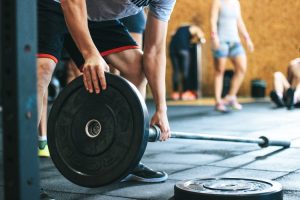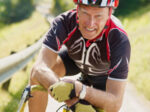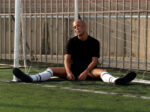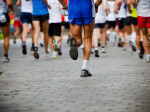 For many people, of all ages, the gym is their second home and strength and conditioning (S&C) their passport to toning, shaping up, improving posture and appearance, gaining confidence and ‘booty’.
For many people, of all ages, the gym is their second home and strength and conditioning (S&C) their passport to toning, shaping up, improving posture and appearance, gaining confidence and ‘booty’.
For serious athletes S&G features credibly in most fitness and sports training programmes aimed at increasing muscle mass and reducing body fat. It seems we are never too old to start with recent research showing that S&C is helpful in slowing down the sarcopenia (muscle and bone loss) that occurs with aging.1
Combining a well designed training program with an energy-rich diet and adequate protein can see weight gains of around 0.25-0.5kg per week if that is your goal.
What is involved and who benefits?
S&C is more than lifting weights- it may include plyometrics (jump training), speed and agility, endurance and core stability with strength being just one part of the training equation. 2
The broad aim is to gain power, strengthen muscle, tendons, ligaments and joints and to improve flexibility and performance while also correcting problems of strength.
The whole body can benefit with the correct training. High intensity intermittent training (HIIT) can be included with strength training to improve circulation, cardiac function and fitness through increased stroke volume and cardiac output. Growth in skeletal muscle and improved metabolism can also be achieved although it is important to talk to your doctor before you begin.
Carried out correctly S&C may also be used in rehabilitation programmes for athletes recovering from injury as well as providing the skills needed for injury prevention which is becoming an important focus in a growing number of sports.
Results are achieved through a combination of correct diet and sets of exercises of variable volume, intensity and duration with rest periods in between.
Quite often athletes want to lose fat and gain muscle simultaneously over a competitive season. However these two goals are often at odds nutritionally because to gain muscle mass requires an increase in energy intake while fat loss usually requires a reduction in energy consumption.
With professional help from a qualified S&C coach and Sports Dietitian (who talk to one another) realistic body composition goals and strategies can be set around a clients training schedules and competition.
Dietary goals
Energy
To increase muscle mass requires sufficient available energy to meet an athletes daily needs according to their age, gender and energy expenditure with enough energy left over to divert into the body building process and growth. 3
Although energy levels may be high this should not provide an excuse for athletes to ‘pig out’ on high fat, high sugar, nutrient poor snacks and takeaways as this will only slow their progress and endanger their longterm heart health.
Protein and carbohydrate
For years it was thought that eating more protein was the key to optimal muscle-building. However most athletes who are training hard already consume an adequate daily intake.
The average daily protein intake for an adult is around 0.8g/Kg/day and for elite athletes between 1.3-1.8g/Kg/day with higher intakes (up to 2.5g/kg/d) during periods of intense training or when reducing energy intakes.3
Consuming high quality protein foods at levels around 1-1.5/Kg/day has been found to help promote bone and muscle growth in the elderly and with care and guidance this can be achieved.1
There is evidence that the timing of protein intake rather than total daily amount per se, is important to maximising the skeletal muscle response to resistance training 4
Good progress can be made by distributing high quality protein widely and evenly across the day, including pre and post training meals and snacks, and when combined with carbohydrate.
In this way the protein stimulates muscle-building while the carbohydrate provides the energy to fuel the training and reduce protein breakdown. Just 20-30g of carbohydrate and 10-20gm of protein taken around training can assist gains in lean muscle mass
Timing is key. If these foods are taken 2-3hrs before training and again within one hour after training then this can meet both muscle-building and any nutrient needs for recovery.
Adolescent athletes report intakes around 1.2-1.6g/Kg/day which is easily consumed using lean protein sources although vegetarian and vegan athletes may need specific dietary advice from their sports dietitian as would any athlete with health issues such as diabetes, allergies, obesity, gut health, iron deficiency, fertility issues etc 3
Fat
Although most athletes are intent on keeping fat intakes low this is still an important source of essential fatty acids and fat soluble vitamins for brain, nerve, skin and eye health etc. A sports dietitian can help athletes get the right balance between saturated, unsaturated fat and cholesterol in order to ensure their long-term health
Practicalities of eating and training
Athletes with small appetites or those unable to eat solid foods prior to training may find it easier to drink their protein and calories in the form of milkshakes; meal replacements; smoothies; fruit juice and sports drinks. Consulting a sports dietitian can help to get this right.
What are some of the risks?
Unqualified advice
Sadly body building, in all its forms, can attract “the cowboys” i.e unqualified instructors selling misleading dietary advice, books, apps, video’s, supplements and overtraining, all of which can lead to a huge loss of form, injury and grief. Extreme care must be taken whatever your age.
Undetected health risks
It’s best to begin with a thorough medical check up and regular tests of heart health, blood glucose and cholesterol levels, renal and liver function and to monitor progress.
This advice applies to fitness instructors as much as their clients who may keep up their diet and fitness for many years in order to “practice what they preach”.
However as one ages the secretion of hormones and enzymes diminish and nutrient needs can increase. This can change the way sugar, fat and cholesterol etc are metabolised and so diet and exercises practices need regular, independent evaluation and adaption to prevent overtraining and nutrient deficiencies occurring over time.
Mental health concerns
While gyms can be happy, friendly places where people meet and engage in cheeky banter they can also be a good place to hide. Spending hours training can be a very lonely and socially isolating pastime.
Equally the pressure and unrealistic demands on some athletes to shape up and compete can create stress causing psychological overload leading to depression, anxiety and “burnout”. 5
An excessive preoccupation with body image can lead to obsessive, compulsive disorders. One such example is Muscular Dysmorphia, an eating disorder also known as reverse anorexia or bigorexia which is tied to muscle-building practices.
Symptoms may include:
- Intense fear of losing weight and withering away.
- Excessive exercise with the aim of bulking up
- Planning, and often neglecting other, life activities around exercise
- Adherence to unconventional diets and the use of steroids or dietary supplements aimed at increasing muscle mass.
This disorder can be difficult to detect because sufferers can look very healthy. However medical help should be sort to rule it out. 6
Young developing athletes
While it can be very tempting for young athletes to hit the weights in school gyms during their lunch breaks extreme care must be taken. The competitive careers of young athletes from all sports are often interrupted or permanently derailed by overuse injuries as a result of disproportionate training and repetitive loading of muscles without sufficient rest and recovery.
This scenario can be played out when young developing athletes transition too rapidly to higher levels of training and competition.
Trying to develop muscles when bones are still growing can lead to serious injuries of the immature spine (e.g.spondylolysis, spondylolististhesis), joint surfaces (osteochondritis dissecans) and traction apophysis or growing pains (e.g. Osgood-Schlatter disease, Sever’s disease). Injuries to epiphyseal growth centers (i.e.growth plates) have the potential to disrupt growth and are of particular concern. 5
Dietary supplements
While the pressure may be great to take dietary supplements and ergogenic aids, in order to gain muscle mass quickly and improve performance, this can place athletes on the wrong side of antidoping rules.
Athletes wanting to take protein shakes, pre-workout shakes, energy drinks, herbal remedies or vitamins should check first with their doctor or sports dietitians. It could be all that is required is a change in diet or exercise plan in order to get better performance.
While it may be cheaper to buy nutritional products over the internet, not knowing the contents of a supplement will not be sufficient defense for any athlete caught doping and can earn them a 4 year ban on sport which could damage their reputation and opportunities in the future.
The main concerns are:
- No supplement is 100% safe
- Supplements can be cross contaminated by other substances during manufacture or by the company to ensure users get results.
- Many substances are incorrectly labelled or may fail to list all the ingredients
- Drug Free Sport New Zealand (DFSNZ) and World Anti-doping Agency (WADA) do not support or endorse ANY supplements 7
If you would like to have a nutritional assessment to check your current diet is matching your sporting goals then contact us today.
For more articles by Lea on similar topics:
- Time your eating for better performance
- What’s to drink?
- Don’t let energy deficiency ruin your health
- Sports supplements should be taken with care
- Dietary help for depressed athletes
- Don’t let disordered eating ruin your performance
- The protein needs of young athletes
- Sports nutrition for senior athletes
References
- Oliveira.C, Dionne.J, Prado.C.M. Are Canadian protein and physical activity guidelines optimal for sarcopena prevention in older adults? Applied Physiology,Nutrition and Metabolism. 10 July 2018
- English Institute of Sport: Strength and Conditioning https://www.eis2win.co.uk/expertise/strength-conditioning/
- Desbrow.B, Burke.L.M, Cox.G, Sawyer.S. Sports Dietitians Australia Position Statement: Sports Nutrition for the Adolescent Athlete. Int. J.Sports Nut & Energy Met. March 2014
- Sports Dietitian’s Australia Fact sheets Increasing muscle mass.
- Bergeron.M, Mountjoy.M, Armstrong.N, Chia.M, Cote.J, Emery.C, Faigenbaum.A, Hall.G, Kriemier.S, Leglise.M, Malina.R, Pensgaard.A.M, Sanchez.A, Soligard.T, Sundgot-Borgen.J, Van Mechelen.W, Weissensteinger.J.R, Endebretsen.L. International Olympic Committee consensus statement on youth athletic development. Br.J.Sports Med.2015 49:843-851.
- Leone.J.E, Sedory.E.J, Gray.K.A. Recognition and treatment of Muscular Dysmorphia and related body image disease. J.Athletic Training 2005 Oct-Dec, 40 (4) 352-359.
- Drug Free Sport NZ https://drugfreesport.org.nz/national-sports-organisations/supplements-and-their-risks/






























































Leave a Reply